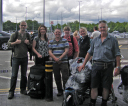Mountaineering, 'Northern Dolomite Medics', Dolomites, Jul 2012, ID 1329
212 Field Hospital RAMC(V)
This Adventurous Training (AT) exercise was conceived, organised and run by Reservists within 212 (Yorkshire) Field Hospital (V), a Territorial Army Unit based in Sheffield and recruiting largely within Yorkshire and Nottinghamshire. The aim was to allow two members of the unit to gain the Rock Climbing Foundation (RCF) qualification, and up to six members to gain the Summer Mountain Foundation (SMF) qualification. These are the basic qualifications required for potential AT leaders wishing to become instructors. A secondary aim was to provide an opportunity for the exercise leader to learn the administrative and logistical processes required to mount such an exercise.
The Dolomite region of Northern Italy was chosen for the challenging nature both of the climbing routes available, and the mountain walking to altitudes of 2800m over difficult terrain. These, combined with the environmental challenges of changeable mountain weather, strong sun and some torrential thundery downpours are typical of the region at this time of year.
Accommodation was at a campsite in Cortina D’Ampezzo for the duration of the exercise - which was conducted as a series of day activities. There were no overnight stays in mountain refuges.
Participants were the author/ exercise leader, Lt Col Gerry Tyrer, and Major Kenny Thompson - instructors in mountain walking and rock climbing respectively. Majors Maund and Malcolm were the RCF students, and Cpls Horrocks and Thompson were trainee instructors both at ML(T) level.
Climbing The quantifiable outcome was that both students achieved their RCF over the exercise period. The climbing routes offered in the Dolomites are some of the most challenging in Europe. Many of the venues involved a short but precarious walk to reach, and climbs ranging from 20m to 120m. The students were challenged with the exposure on many occasions, but quickly overcame their trepidation and proved to be capable. They quickly understood the concept of the challenging environment as they abseiled from the end of the climbs in hail and rain, experiencing the challenging nature of mountain weather.
Walking Day routes followed way-marked routes at five different locations. Being well marked on the ground, they presented little navigational challenge. They did, however, offer the opportunity to walk at an altitude of 2,800m (twice as high as in UK) and invaluable experience in route planning (map contours were 25m intervals rather than the 10m widely used in UK); safety on steep ground (some descents in particular were precipitously steep and required careful negotiation), and weather-awareness (strong sun and significant winds at altitude). The quantifiable outcome is that all three walkers gained five good quality mountain days (QMD) for their log diaries.
Exercise planning The author took on the exercise planning in late March and benefited initially from considerable help from the Regular cadre in gaining approval from the relevant authorities. Subsequently, he relied heavily on other Reservist AT leaders for guidance and support in the detailed planning and submission. The assistance of the Training Officer, Major Bob Newnham and of one of the sailing instructors, SSgt Alex Orr, is gratefully acknowledged. The qualitative outcome is a greater confidence and competence to plan and deliver similar exercises in the future, having appreciated the various authorities to be consulted, the timelines involved, the level of information needed for exercise submission and the need to plan early and in detail.
Cultural Activites Accidentally, the climbers discovered a geo-cache at Sas De Stria and logged the first entry for twelve years!
The final day involved a visit to the First World War museum of Monte Piana / Monte Piano. This plateau was the scene of fierce fighting between Italian and Austrian forces from 1915 to 1917 and accounted for over 14,000 dead and countless more wounded on both sides. Many of the trenches, tunnels and fortifications from nearly one hundred years ago are preserved, and the strategic points on the battlefield are signed and their significance explained.
The generous support of the Ulysses Trust is gratefully acknowledged in the delivery of this challenging exercise.
Thanks to
|

|
working in partnership with
|

|




